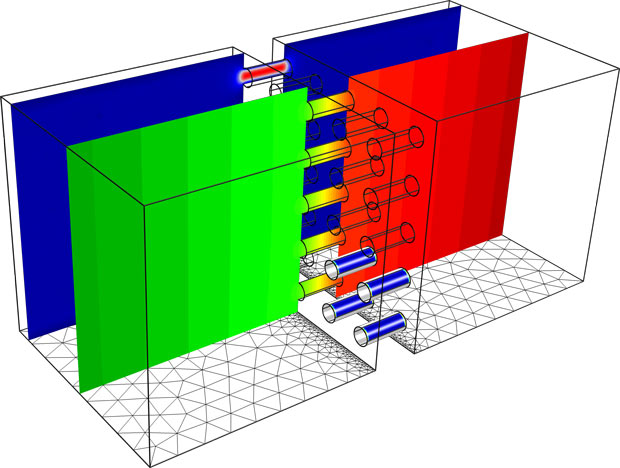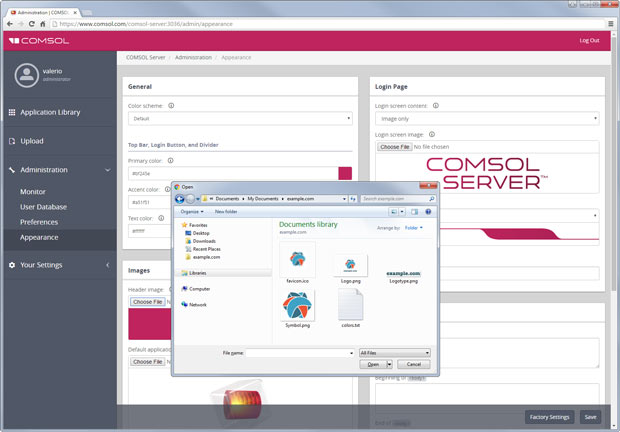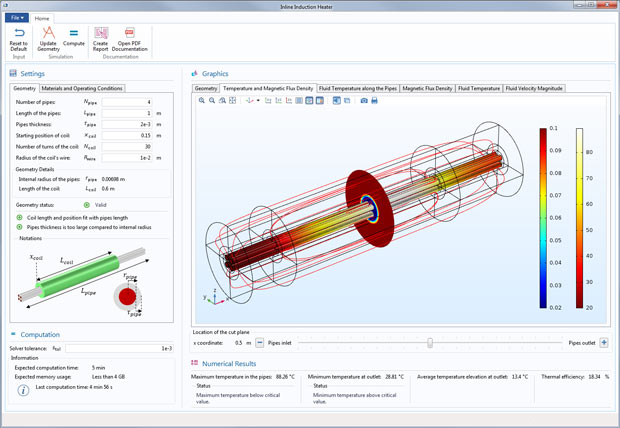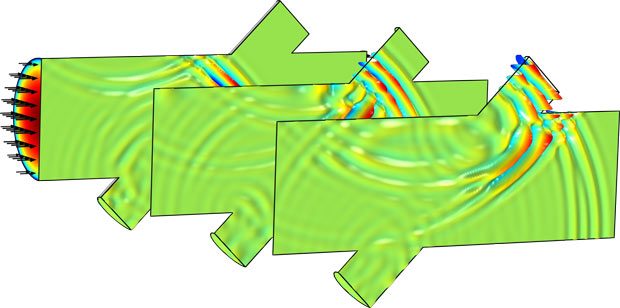
This thermo-viscous acoustics simulation was solved with the new domain decomposition solver introduced in COMSOL 5.2a. Shown are local acceleration, total acoustic pressure and total thermo-viscous power dissipation density. This model consists of 2.5 million degrees of freedom and required 14GB of RAM to solve. Previously, solving this simulation needed 120GB of RAM using a direct solver. Image courtesy of COMSOL Inc.
Latest News
June 22, 2016
Multiphysics modeling, simulation and application design software provider COMSOL Inc. has announced version 5.2a of its COMSOL Multiphysics and COMSOL Server simulation software environment. Version 5.2a, says COMSOL, delivers “hundreds of user-driven features and enhancements” to the core COMSOL Multiphysics solution and COMSOL Server. COMSOL 5.2a sees expansions of its geometry and meshing functionalities as well as new application design and deployment tools. The COMSOL suite of physics-specific modules for such applications as electrical, mechanical, fluid and chemical design and optimization also see major updates, including new solvers and methods.
 Beginning with version 5.2a, administrators can customize the visual theme of the COMSOL Server web interface. Colors, logos and log-in screen can be customized and HTML code added for branding purposes. Image courtesy of COMSOL Inc.
Beginning with version 5.2a, administrators can customize the visual theme of the COMSOL Server web interface. Colors, logos and log-in screen can be customized and HTML code added for branding purposes. Image courtesy of COMSOL Inc.The COMSOL Application Builder toolkit for designing, optimizing and creating specific-purpose, shareable apps introduces many new features in version 5.2a. App designers can now build dynamic apps where the appearance of the user interface changes during run time and apps that include hyperlinks and videos. A new Add Multiphysics window lets app designers create multiphysics models incrementally by providing a list of available predefined multiphysics couplings for the selected physics interfaces. Other enhancements include the ability to centralize unit handling for teams working across different countries and autocomplete now covers more fields, such as equation view fields.
For geometry and mesh manipulation, version 5.2a’s tetrahedral meshing algorithm has been enhanced so users can now make coarse meshes for complicated CAD geometries that feature many thin parts. A new optimization algorithm built into the mesher is available for improving element quality, which, says COMSOL, may improve the accuracy of a solution and make it faster to converge. Interactive drawing for 2D geometries now features better coordinate display and snapping points.
 This app example comes with the Application Libraries included in COMSOL Multiphysics and COMSOL Server, It can be used for the design of a magnetic induction device used for food processing. Image courtesy of COMSOL Inc.
This app example comes with the Application Libraries included in COMSOL Multiphysics and COMSOL Server, It can be used for the design of a magnetic induction device used for food processing. Image courtesy of COMSOL Inc.For mathematical modeling, studies and visualization, COMSOL Multiphysics 5.2a offers three new solvers: A smoothed aggregation algebraic multigrid (SA-AMG), domain decomposition and an explicit solver based on the discontinuous Galerkin (DG) method. All, says COMSOL, deliver fast and memory efficient computations.
The SA-AMG solver, according to the company, is particularly efficient for linear elastic analysis, yet is applicable to many other types of analyses. COMSOL says it is memory conservative, making it possible to run structural assemblies with millions of degrees of freedom on standard desktops or laptop computers.
The domain decomposition solver is optimized for handling large multiphysics models. The company explains that it provides a robust and flexible technology to efficiently compute strongly coupled multiphysics applications, which previously required a memory-hungry direct solver.
 This COMSOL numerical simulation of a transient time-of-flight ultrasound flow meter shows ultrasound signals propagating in the device at different time steps. The interface is based on COMSOL 5.2a’s new discontinuous Galerkin (DG) method. Image courtesy of COMSOL Inc.
This COMSOL numerical simulation of a transient time-of-flight ultrasound flow meter shows ultrasound signals propagating in the device at different time steps. The interface is based on COMSOL 5.2a’s new discontinuous Galerkin (DG) method. Image courtesy of COMSOL Inc.For acoustics simulations, a new explicit solver combines the DG method with new absorbing layers in the time-domain. This “results in a level of memory efficiency that will allow [users] to perform more realistic simulations than ever possible before for a given memory size,” said Mads Jensen, COMSOL’s technical product manager, Acoustics, in a press statement.
The Structural Mechanics module in COMSOL 5.2a now has an adhesion and decohesion feature for analyzing processes involving mechanical contact with parts that stick together and pull apart as well as a new physics interface for modeling linear and nonlinear magnetostriction. The CFD (computational fluid dynamics) and Heat Transfer modules now offer a feature that adds a gravity force and concurrently compensates for hydrostatic pressure on boundaries.
For chemical simulations, surface reaction in reactive pellet beds and a new reacting flow multiphysics interface are available. Users of the Batteries & Fuel Cells module can now model complex 3D assemblies in battery packs using a new single particle battery interface. Discharge and recharge behaviors are supplied by the single particle model at every point in the geometry, making it possible to estimate the geometrical current density distribution and the local state of charge in a battery pack.
 This thermo-viscous acoustics simulation was solved with the new domain decomposition solver introduced in COMSOL 5.2a. Shown are local acceleration, total acoustic pressure and total thermo-viscous power dissipation density. This model consists of 2.5 million degrees of freedom and required 14GB of RAM to solve. Previously, solving this simulation needed 120GB of RAM using a direct solver. Image courtesy of COMSOL Inc.
This thermo-viscous acoustics simulation was solved with the new domain decomposition solver introduced in COMSOL 5.2a. Shown are local acceleration, total acoustic pressure and total thermo-viscous power dissipation density. This model consists of 2.5 million degrees of freedom and required 14GB of RAM to solve. Previously, solving this simulation needed 120GB of RAM using a direct solver. Image courtesy of COMSOL Inc.Other enhancements introduced in version 5.2a include magnetic vector hysteresis for modeling transformers and ferromagnetic materials in the AC/DC module; domain terminal boundary conditions for easier simulation of touchscreens and MEMS (micro-electrical-mechanical systems) devices; ray-tracing simulations can combine graded index and constant index materials in meshed and unmeshed domains; and a new Optical Aberration plot type for measuring monochromatic aberrations. For high-frequency electromagnetics analysis, two-port networks, fast-frequency sweeps and nonlinear frequency-mixing are now available.
For complete details on COMSOL Multiphysics, COMSOL Server and the COMSOL Multiphysics suite, click here.
Go here for Version 5.2a release highlights and intro video.
Attend the live webinar “Introducing COMSOL Multiphysics and COMSOL Server 5.2a” on June 24.
Sources: Press materials received from the company and additional information gleaned from the company’s website.
Subscribe to our FREE magazine, FREE email newsletters or both!
Latest News
About the Author
Anthony J. Lockwood is Digital Engineering’s founding editor. He is now retired. Contact him via [email protected].
Follow DE





